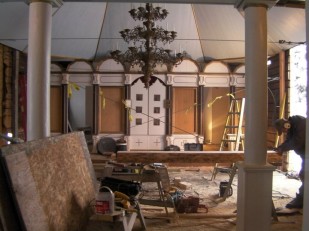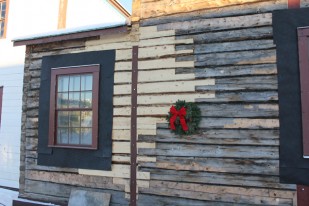Telling the SAT Story: Holy Assumption Orthodox Church
Holy Assumption Orthodox Church
Kenai, Alaska
Year of Award: 2008
National Park Service SAT Grant: $125,492
Matching Share Leveraged: $129,895
Save America’s Treasures (SAT) grants operate to preserve the country’s cultural landmarks, and in contemporary Alaska, one can find lasting Russian and Native American cultural influences that reflect its history and heritage. Artifacts that reflect the Russian Orthodox faith are prominent throughout the state, and in coastal Kenai (in the south central region of the state, on the Kenai Peninsula) stands the oldest standing Russian Orthodox Church in Alaska, the Holy Assumption Orthodox Church.
The church served as a medical, educational and judicial center for fur traders and residents in the late 1790s. After the first smallpox epidemic hit the region in the late 1700s, a Russian Orthodox priest acquired a vaccine for the disease to prevent another epidemic, and parish priests started the first school in Kenai at the church.
The church’s architectural details include its uncovered exterior log walls in the traditional Russian ship (Pskov) design, the blue, green, and gold features, and onion-shaped domes (a famed characteristic of Russian ecclesiastical architecture). Its craftsmanship indicates the pride the Russian Orthodox community took in their faith and culture, and Holy Assumption grew to become one of the state’s most visited historic landmarks.
Nationally designated a National Historic Landmark in 1970s, Holy Assumption has a culturally rich history, but by the late 20th century, continued exposure to moisture and harsh winds had weathered the church’s exterior to the point of near deterioration. Furthermore, the foundation was cracked, and no longer provided a solid structural connection to the building.

The exterior’s log construction was badly deteriorated prior to the restoration.
To prevent the loss of such a critical cultural site, the Russian Orthodox Sacred Sites in Alaska (ROSSIA) took action to restore the church’s structural integrity. Through the SAT grant, ROSSIA began to tackle the repairs. Dorothy Gray, ROSSIA Board Member and Holy Assumption treasurer, said, “To see [the logsmiths] working, it looked like a photo from a century ago. Huge piles of moss were piled inside. When a new log was set in place, the moss was pushed between the logs, just as it was originally done in the early 1880s when the church was under construction.” Structural engineers further ensured the building’s structural support via the installation of steel support rods, which are invisible from the interior and exterior of the church, and created an ADA-accessible entry for disabled and elderly visitors.
Inside, preservation experts worked to restore Russian Orthodox iconography, artifacts, journals, and notes, some of which date back to the early 1700s. Each piece was carefully removed from the church interior and individually restored. For the duration of the church’s reconstruction, the impressive collection of restored iconography was temporarily donated to the museum at the Kenai Visitor and Cultural Center. There, the Center’s curator recreated the church interior for the exhibit, which drew the largest number of visitors the Center had ever experienced.

The interior renovation included Russian Orthodox iconography and documents dating back to the 18th century.
As the restoration of the church neared completion, local and state media began to publicize the project, and interest in Holy Assumption grew rapidly. When it reopened to the public in 2010, the number of visitors—and donations the church received—demonstrated a noticeable spike in interest. This renewed support from the community and from visiting tourists fostered additional public and private funding, which enabled ROSSIA to plan for a more holistic restoration to include the roof and bell tower. Gray continued, “The Save America’s Treasures grant was a true catalyst. [It supported] phase one of the project, and thanks to additional funders, we have completed phase two, and are about to start phase three.”

View of the restored exterior showing new square-hewn logs, lap-jointed in, replacing deteriorated portions of the original log structure.
Holy Assumption continues to experience an increase in visitors who are interested in learning more about this piece of Alaskan history. “History is a part of who we are. By looking into the past, it helps us better understand where we are and our place in the community. Through the renovation, we’ve given the people a sense of place of where they live,” said Gray.
For more information on Holy Assumption or ROSSIA, visit http://oca.org/ or http://www.rossialaska.org/.
—
Established in 1999, the Save America’s Treasures program is managed by the National Park Service, with the National Endowment Agencies, to preserve and protect nationally significant properties and collections for future generations of Americans. Stories of saving those treasures will be shared through partnership with the American Architectural Foundation.
Photos courtesy of Flickr user J. Stephen Conn and Dorothy Gray, lead parishioner at Holy Assumption.

.


